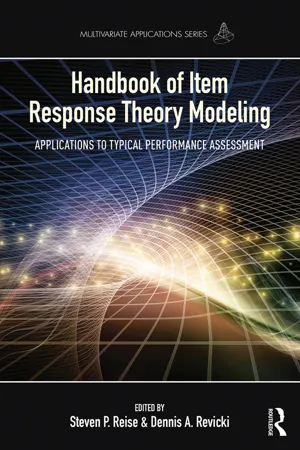
Handbook of Item Response Theory Modeling
Applications to Typical Performance Assessment
- 466 pages
- English
- ePUB (mobile friendly)
- Available on iOS & Android
Handbook of Item Response Theory Modeling
Applications to Typical Performance Assessment
About this book
Item response theory (IRT) has moved beyond the confines of educational measurement into assessment domains such as personality, psychopathology, and patient-reported outcomes. Classic and emerging IRT methods and applications that are revolutionizing psychological measurement, particularly for health assessments used to demonstrate treatment effectiveness, are reviewed in this new volume. World renowned contributors present the latest research and methodologies about these models along with their applications and related challenges. Examples using real data, some from NIH-PROMIS, show how to apply these models in actual research situations. Chapters review fundamental issues of IRT, modern estimation methods, testing assumptions, evaluating fit, item banking, scoring in multidimensional models, and advanced IRT methods. New multidimensional models are provided along with suggestions for deciding among the family of IRT models available. Each chapter provides an introduction, describes state-of-the art research methods, demonstrates an application, and provides a summary. The book addresses the most critical IRT conceptual and statistical issues confronting researchers and advanced students in psychology, education, and medicine today. Although the chapters highlight health outcomes data the issues addressed are relevant to any content domain.
The book addresses:
IRT models applied to non-educational data especially patient reported outcomes
Differences between cognitive and non-cognitive constructs and the challenges these bring to modeling.
The application of multidimensional IRT models designed to capture typical performance data.
Cutting-edge methods for deriving a single latent dimension from multidimensional data
A new model designed for the measurement of constructs that are defined on one end of a continuum such as substance abuse
Scoring individuals under different multidimensional IRT models and item banking for patient-reported health outcomes
How to evaluate measurement invariance, diagnose problems with response categories, and assess growth and change.
Part 1 reviews fundamental topics such as assumption testing, parameter estimation, and the assessment of model and person fit. New, emerging, and classic IRT models including modeling multidimensional data and the use of new IRT models in typical performance measurement contexts are examined in Part 2. Part 3 reviews the major applications of IRT models such as scoring, item banking for patient-reported health outcomes, evaluating measurement invariance, linking scales to a common metric, and measuring growth and change. The book concludes with a look at future IRT applications in health outcomes measurement. The book summarizes the latest advances and critiques foundational topics such a multidimensionality, assessment of fit, handling non-normality, as well as applied topics such as differential item functioning and multidimensional linking.
Intended for researchers, advanced students, and practitioners in psychology, education, and medicine interested in applying IRT methods, this book also serves as a text in advanced graduate courses on IRT or measurement. Familiarity with factor analysis, latent variables, IRT, and basic measurement theory is assumed.
Frequently asked questions
- Essential is ideal for learners and professionals who enjoy exploring a wide range of subjects. Access the Essential Library with 800,000+ trusted titles and best-sellers across business, personal growth, and the humanities. Includes unlimited reading time and Standard Read Aloud voice.
- Complete: Perfect for advanced learners and researchers needing full, unrestricted access. Unlock 1.4M+ books across hundreds of subjects, including academic and specialized titles. The Complete Plan also includes advanced features like Premium Read Aloud and Research Assistant.
Please note we cannot support devices running on iOS 13 and Android 7 or earlier. Learn more about using the app.
Information
Fundamental Issues in Item Response Theory
1
Introduction
Educational Versus Noneducational Measurement
Table of contents
- Cover
- Half Title Page
- Series Page
- Title Page
- Copyright Page
- Dedication
- Table of Contents
- About the Editors
- Contributors
- Preface
- Acknowledgments
- PART I Fundamental Issues in Item Response Theory
- PART II Classic and Emerging IRT Modeling Approaches
- PART III Using IRT Models in Applied Problems
- Index